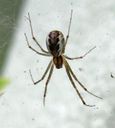European Sheetweb Spider
Linyphia triangularis
Classification
- Phylum: Arthropoda
- Subphylum: Chelicerata
- Class: Arachnida
- Order: Araneae
- Infraorder: Araneomorphae
- Family: Linyphiidae
- Subfamily: Linyphiinae
- Genus: Linyphia
- Species: triangularis
Pronunciation
How to pronounce Linyphia triangularis: //lɪˈnɪfiə traɪˌæŋɡjəˈlɛərɪs//
These audio files are automatically generated. While they are not always 100% accurate, they are a good starting point.
Images






Summary
Linyphia triangularis is a small European spider species from the family Linyphiidae, characterized by its unique abdominal markings and horizontal sheet-web construction. It is known for its role in local ecosystems as a predator of small insects and has recently been introduced to parts of North America.
Physical Characteristics
Grows up to 6 mm long. Carapace is pale brown with darker markings along the edges and down the center line. The opisthosoma has a coarsely serrate brown band against a white background, with further brown markings along the sides. Legs are greyish brown and bear many long spines.
Identification Tips
Compare the side patterning of the abdomen with Pityohyphantes species; Linyphia triangularis has distinctive tuning-fork markings on the carapace that do not extend to the posterior eye row unlike Pityohyphantes spp. A poor shot of the epigynum can also aid identification due to the distinctive spoon-shaped scape of Pityohyphantes.
Habitat
Found among low bushes and vegetation, spins a horizontal sheet-web in its habitat.
Distribution
Abundant throughout Europe; introduced to Maine, USA, first reported there on August 28, 1983, and established in at least 15 of the 16 counties, now abundant in Acadia National Park and other coastal regions of Maine.
Diet
Preys on insects caught in its web, which are killed by Linyphia triangularis but not wrapped in silk.
Ecosystem Role
Plays a role in controlling insect populations as a predator.
Similar Taxa
Tags
- Linyphia triangularis
- European Sheetweb Spider
- Linyphiidae
- spider